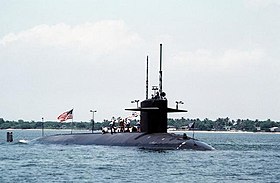Thresher class
 The Greenling in 1990 on the surface of the water |
|
| Overview | |
|---|---|
| Type | Hunting submarine |
| units | 14 built, 0 in service |
| Namesake | Thresher Shark / Trachinotus |
| period of service |
1961 to 1996 |
| Technical specifications | |
| displacement |
4300 to 4600 tn.l. submerged |
| length |
84.9 to 89.5 meters |
| width |
9.8 meters |
| Draft |
8.8 meters |
| Diving depth | approx. 400 meters |
| crew |
143 |
| drive |
S5W pressurized water reactor, 1 propeller |
| speed |
30 knots |
| Armament |
4 × 533 mm torpedo tubes |
The Thresher class (after the sinking of the type ship also Permit class after the second unit) was a class of atomic powered submarines of the United States Navy .
history
Planning and construction
Planning for the Thresher class began in the mid-1950s. Originally, the boats should be built as cruise missile carriers . However, after the Navy decided in late 1958 under Secretary of the Navy Thomas S. Gates to stop the development of this type in order to direct funds into the programs for ballistic missile submarines and aircraft carriers , the boats of the class became fighter submarines. In 1960 the first unit was launched. In 1963 this boat, the USS Thresher (SSN-593), was lost in a test accident . Therefore, the construction of some units of the class was delayed considerably, with the later boats there were up to seven years between keel laying and commissioning. This range was three years for the first units. The delay was due to the integration of changes that were decided after the loss of the Thresher in the SUBSAFE program.
A total of 14 units were built, three each at Ingalls Shipbuilding , New York Shipbuilding , Electric Boat and Portsmouth Naval Shipyard and two at Mare Island Naval Shipyard . The cost was approximately $ 55 million per unit.
Working time
The successors to the Sturgeon class entered service in 1967 and, with the permits, made up a large part of the Navy's hunting submarine fleet. The boats remained in service until the early / mid-1990s and were replaced by the Los Angeles and Seawolf classes .
technology
The hulls of the units that ended early are 84.9 meters long, while that of four of the later boats is 89.1 and 89.4 meters long, because they had already integrated improvements from the SUBSAFE program. The displacement was between 4,300 ts and 4,600 ts. The hull was made of highly elastic HY-80 steel . This means that the steel has a guaranteed 'yield strength' ( yield strength ) of 80,000 psi ( pounds per square inch has). That corresponds to approx. 5,516 bar . The yield strength is a material parameter and describes the stress up to which a material does not show any permanent plastic deformation under uniaxial and moment-free tensile stress. It is a flow limit. Another advantage of this steel, which is mainly used for shipbuilding, is its good weldability.
The nuclear reactor gave the ships virtually unlimited range and a top speed of 30 knots.
The boats of the class had four torpedo tubes with a diameter of 53.3 cm, from which the UUM-44 Subroc , the Mark-48 heavyweight torpedo , the anti-ship missile UGM-84 Harpoon or the cruise missile UGM-109 Tomahawk could be shot.
Web links
- Thresher class on globalsecurity.org (English)
Footnotes
- ^ Norman Polmar, KJ Moore: Cold War Submarines: The Design and Construction of US and Soviet Submarines, 1945-2001. Potomac Books, Dulles, VA 2003. ISBN 978-1-57488-594-1 , p. 91.